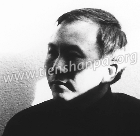
Our first article is an interview with 64th-generation Tien Shan Pai Grandmaster Huang Chien-Liang (reprinted with permission from the the Jan./Feb. 1998 issue of the Wu Gong Journal of Chinese Martial Arts. For purchase and subscription information, contact the Wu Gong Journal at 1370 Main Street, Dunedin FL 34698, (727) 734-8222).
Wu Gong: When did you start martial arts training?
Huang Chien-Liang:
I started training martial arts in Malaysia as a child. In those days we had a great deal of respect for our Shifu and were too afraid to ask any questions. I would say my formal training started in 1960; I started studying Southern style. In 1966 I moved to Taiwan to study Taiji Quan from Wang Chueh-Jen. After I had studied with him for a while, he asked me if I would like to learn Northern style Kuo shu (Gongfu). In the summer of 1972, after I graduated from college, I was invited to come to the United States to teach, so I spent the next eight months concentrating on just training to better prepare me for my trip.
WG: Can you provide us with a brief history and a description of the characteristics of Tien Shan Pai?
HCL:
Tien Shan Pai Gongfu originated in the Hsing Chiang Province in northwestern China. Legend has it that it was practiced by monks who lived in a temple nestled among the snow-capped peaks of that region’s rugged terrain. As the story goes, a young herdsman was searching for lost animals and wandered too far from home. The grasslands he knew so well suddenly looked unfamiliar and he realized that he was lost. Noticing an old monk with a long white beard approaching nearby, the boy stopped him and asked for directions. When he returned to his village, the boy told his mother about the old monk. She replied that he had met Tien Shan Lao Learn, a monk who was noted for his martial arts skills. The mother encouraged her son to find the monk and learn his Gongfu secret.
The young boy set out to find the old monk. His quest carried him deep into the mountains. Mile after mile, he searched out but could not find the old monk. At the point of physical exhaustion, the young boy stopped at a nearby stream to quench his thirst. While kneeling by the stream, he saw a reflection of a beautiful temple nestled in a snow-capped mountain. Sensing that he was close, the young boy continued his search for the old monk.
After a long journey into the mountains, the boy found the temple, but his hopes were dashed when the monk refused to accept him as a disciple. They were not permitted to teach outsiders, the monk explained. Instead of going home as they suggested, they boy knelt in the snow outside the temple doors. On the second morning, he was discovered lying unconscious from the cold and was taken into the temple.
Seeing his determination, the old monk reconsidered. Tien Shan Lao Learn decided to teach the boy, whom he nicknamed Hong Yein (Red Cloud) because of the mist that rose from his bleeding knees. He stayed in the temple until he grew to manhood, and when he left, he eagerly passed on his skill to other dedicated students. Hong Yein Chu Shih, as the first to teach the monk’s martial artistry to the outside world, is regarded as the founder of Tien Shan Pai.
A more recent description of our history would be from Wang Chueh-Jen. He was very small in stature and was not able to enlist in the military, however, due to his very high level of skill in the martial arts, the military hired him to teach combat training to the Special Forces. This training consisted of all fighting, and Wang would have to train with these men hands on. It was from this fighting experience that he developed “Radar” fighting, which gives practitioners the ability to better judge their opponent’s movements. Tien Shan Pai also emphasizes moving to the side (called “Mi Zong Bu”, meaning “lost step”). Together, these two concepts give the practitioner what some have called the art of disappearing and has proven itself very effective in Kuo shu Lei Tai fighting in the early 1950’s when there were no weight classes, no rounds, and the only protection was a pair of thin cotton gloves.
In 1957, one of the biggest and most famous tournaments in the world was held. This was the Kan-Tai Hauo (Hong Kong, Taiwan, and Macau) and it contained some of the best fighters from all around, including some very famous fighters originally from mainland China. In this tournament, they divided into three weight categories and added time rounds. Tien Shan Pai proved very effective at this prestigious event, with my classmate Wu Ming-Zhe winning in the lightweight division.
When a student reaches a high enough level in our system, they train in the advanced stage called “Tien Ing” or “Tien Shan Eagle”. Tien Shan Pai belongs to the northern style; we have all northern style characteristics plus our style contains “Ingshou” or “sound rhythym”. Even today, my students not only have won in full contact fighting, but in forms and weapons competitions from major world tournaments.
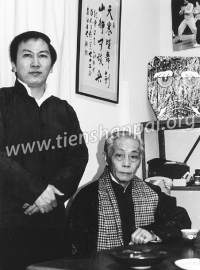
WG: Your teacher, Wang Chueh Jen, was very famous. Would you please share some information about him with our readers?
HCL:
My teacher was very traditional in his teaching, meaning very strict. I can remember the only time that we were allowed to talk in class was while we would hang our foot in a tree stretching. My teacher was very confident in himself; most people would assume this was because his external martial art is very famous. After I studied from him for a while, he trained me in Taiji Quan and Ba Gua Zhang self defense. In time, I learned step by step how to use the internal martial arts for Lei Tai fighting. After this I realized that no matter how famous my teacher’s external martial art was, I found his internal arts even more amazing. I have wanted to teach what I learned from the internal arts for Lei Tai fighting, but in my area most people only want to train for health or self defense, not full contact fighting.
WG: Was Wang Chueh Jen responsible for incorporating Xing Yi, Taiji, and Ba Gua in the Tien Shan Pai curriculum, or was this done before his time?
HCL:
Tien Shan Pai is Tien Shan Pai. Xing Yi Quan, Taiji Quan, and Ba Gua Zhang are from the three internal systems and are not a part of Tien Shan Pai. Like any other external martial art system, Tien Shan Pai does contain its own martial Qigong, Neigong, traditional pole training, as well as Qin-na. I do teach the internal systems mentioned above, but we are training them separately.
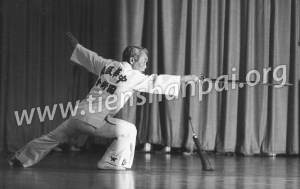
WG: In the early 1980’s (I cannot remember the year), I was privileged to watch a demonstration at Cleveland State University which featured Wang Chueh Jen, and other Tien Shan Pai members. I watched Wang Chueh Jen perform the double saber and the San Sai Jien two man sword fighting set. Even at an advanced age, Wang displayed remarkable speed and agility. Do you recall this event?
HCL:
I do recall the event you mentioned. It was in 1981. I was not in attendance. I had invited my teacher to the United States and during that time he traveled to another city to visit my classmate. My classmate knew a professor at Cleveland State University, and they invited my teacher to give a Nei Gong seminar and demonstration. The solo performance you saw is the same one that earned him the title “Divine Double Broadsword King of China”. What is even more amazing was in 1985, on my teacher’s third visit to the U.S., he taught my student, Rick Wheatley, a drunken style form. Wang not only taught the form, but he personally demonstrated the hard fallen techniques. You don’t expect to see a double flying sidekick with a free fall from a 75 year old. Everyone was completely amazed, including me. I only wish he had allowed us to videotape his performance. I have traveled China, Taiwan, and around most of the world, but I have never seen anyone perform like him.
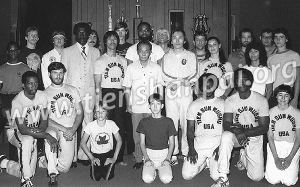
WG: You moved to the United States in 1973 and later opened your first school in Cincinnati, Ohio in 1975. Can you talk about your first experiences of living and teaching in the U.S.?
HCL:
When I arrived in the United States, I was very confident in myself. I thought that if you are good and you open a school that people would automatically join. I soon realized that in the U.S. you need a strong marketing strategy to survive. At that time I had to work in a restaurant so that financially I could keep the school open. In 1983, I moved back to the east coast to open another school. In the beginning I still had to continue to work, but after advertising in the yellow pages and some local newspapers, I was able to work full time in the school by 1984.
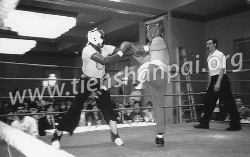
WG: In 1983 you moved to Maryland. When did you sponsor the first Kuo shu tournament, and what were you reasons for doing so?
HCL:
In 1986, Dr. Pai was in charge of the United States Kuo shu Federation (U.S.K.F.). In June of that year he sponsored his first Kuo shu tournament in Florida. At that time, we spoke and discovered we both shared the same idea of promoting Kuo shu, including that event should be held in a first class facility. In 1987 he sponsored his second tournament, but it did not get enough support from the Chinese Martial Arts community. Shortly after this, his students asked if I would be willing to take over, and I was eager to do so. I wanted people everywhere to realize that Chinese Kuo shu is a first class sport. I also wanted to do this in a friendly atmosphere, and in order to achieve this I demanded that my students be friendly and extend courtesy to everyone. In my first year sponsoring a tournament, I had 102 competitors register; since then I have had 600 competitors for the past few years. My goal was to attract between 400-500 competitors, keeping quality as my first concern. I have never measured success by the number of applicants, but rather: did everyone enjoy themselves and was everyone treated fairly. My hope is that if I can promote Chinese Kuo shu as a first class sport, then everyone will communicate and we can all unite. Unfortunately, not everyone gives martial arts a good name. I hope to change that. I feel if you don’t treat people with courtesy, they will not come. So, I fell we must first promote martial ethics.
WG: Can you share with the reader the purpose of the United States Chinese Kuo shu Federation as well as that of the International Chinese Kuo shu Federation?
HCL:
The purpose of the United States Chinese Kuo shu Federation (U.S.C.K.F.) is to promote friendship, unity, physical and mental fitness, harmony, ethics, and peace through the principles of Chinese Martial Arts. Each year the U.S.C.K.F. sponsors several national or international tournaments and seminars designed to help achieve these benefits. The International Chinese Kuo shu Federation ideals are the same, but we help to bring people together on an even more global level. Due to my position as Vice-President to the I.C.K.F. and President to both the Pan-American Chinese Kuo shu Federation and the U.S.C.K.F., I am honored to be of service to these organizations working to bring martial artists from around the world closer together.
WG: As the President of the U.S.C.K.F., what is your role and mission?
HCL:
As President of the U.S.C.K.F. my mission is to promote Chinese Martial Arts as the first class sport that it is, to provide the best quality and fairest tournaments, all in a friendly atmosphere, and to offer to the public the best seminars and most exciting spectator events given anywhere. My role as president not only keeps me traveling in the U.S., but around the world as well.
WG: Can you talk about the ranking system which is being implemented by the I.C.K.F.?
HCL:
The ranking system that the I.C.K.F. has implemented is the first time a world organization has provided, to each country, two kinds of ranking. The ranking can be divided into Regular and Honorary. Points may be received by competing in a sanctioned tournament and/or promoting and sponsoring sanctioned events, just to name a few. The type of event also affects the amount of points; for example, a World Tournament offers more points than does a National Tournament. Finally, age does play a factor in attaining rank. Even though I have earned over 500 points, I still cannot receive the rank of Tenth Degree until I turn age 65. Students of any age may receive ranking under first degree black sash, however you must be at least 16 years old to earn First Degree Black. Anyone earning First Degree and above will receive a certificate by the I.C.K.F. and their sash will come with the I.C.K.F. logo and the student’s name inscribed on it. The advanced ranking goes as follows: First through Fifth Degree receives a black sash, Sixth through Eighth degree receives a red sash, and Ninth and Tenth Degree will receive a gold sash.
WG: Your tournament is regarded as one of the premiere Chinese martial arts events to take place each year in the United States. What new plans do you have for the tournament in the future?
HCL:
Thank you for your kind words. There is no doubt that I appreciate all the support given by everyone that helps make us one of the nation’s most premiere tournaments. I still believe we are never perfect, so we must work harder each year to try and improve. I hope to raise Chinese Kuo shu to where we can hold professional Lei Tai Fighting with Forms and Weapons competition as well. In order for this to take place, the U.S.C.K.F. will need to raise a lot of financial support to fund this type of event. I am hopeful that, though media such as this, we may spark an interest.
WG: You have received many awards. Of all your achievements, is there one which you cherish the most?
HCL:
As you mentioned, I have received many different awards from several different organizations and I certainly cherish them all. If I had to pick out one, I would have to say that receiving the Governor’s Proclamation, every year since 1991, proclaiming our tournament as “Chinese Kuo shu Week” is the biggest honor, because I accept it on behalf of all of those who work so hard to promote Chinese Martial Arts.
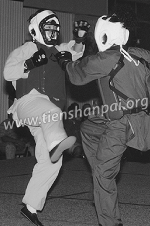
WG: What is in store for you in the future?
HCL:
I believe in less talk and more action. In my future, I will continue to promote and teach the Chinese Martial Arts. Even though I am not famous, I have traveled and met many famous people and earned their respect by doing more and talking less.
WG: Besides being the President of the U.S.C.K.F. you are 64th Grandmaster of Tien Shan Pai (having succeeded Wang Chueh Jen after his passing). What are your responsibilities regarding this position?
HCL:
Succeeding my teacher is a great honor, but it carries a great burden. Over the past few years I have not been able to promote Tien Shan Pai as much as I would like due to my duties with the U.S.C.K.F. Recently, I am very pleased to announce, I have founded the Tien Shan Pai Association, which is being promoted not just in the U.S., but in Europe as well. Tien Shan Pai has already earned major recognition for its competition in fighting, forms and weapons divisions. I am proud to promote and carry the Tien Shan Pai lineage on for generations to come.

WG: What is in store for you in the future?
HCL:
I believe in less talk and more action. In my future, I will continue to promote and teach the Chinese Martial Arts. Even though I am not famous, I have traveled and met many famous people and earned their respect by doing more and talking less.
